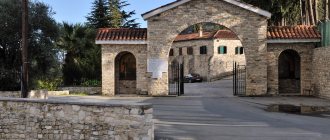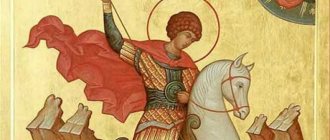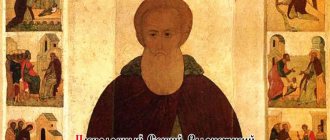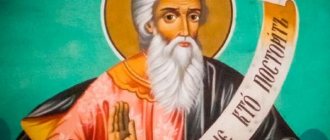On November 2, the entire Orthodox world celebrates the day of remembrance of the Holy Great Martyr Artemios of Antioch. For centuries, this holiday on Russian soil was called “Wolf Day”, as well as the Day of Atamans. And this was connected with many interesting customs, in which both Orthodox and pagan traditions were intricately intertwined.
Steadfast commander
Artemius of Antioch was born in the first half of the 4th century in the Roman Empire. Unfortunately, history has left no information about his origin, but it is known that from his adolescence he devoted his life to army service. The gifted young man quickly proved himself to be a talented strategist and tactician, for which he was appointed military leader by Constantine the Great himself. Together with the emperor, Artemy took part in many famous campaigns and warmly supported the ruler in his efforts to strengthen the Christian faith. After the death of Constantine, his son Constantius, just like his father, who deeply respected the wise commander, appointed him governor of Egypt. Artemy ruled his province, supporting the Christian faith in everything. However, everything changed when Julian the Apostate ascended to the throne of Constantinople, who went down in history as the last pagan of the great empire. Under him, persecution of Christians resumed, accompanied by brutal executions. Once, while in Syrian Antioch, Julian ordered the capture and execution of two bishops. However, Artemy, who was passing through the city at that time, stood up for the unfortunate people, publicly condemning the actions of the emperor. The angry monarch, without regard for the commander’s merits, immediately ordered his arrest and throwing him into prison. For several days, Artemy was subjected to terrible torture, during which the executioners demanded that he renounce Christ, but the brave warrior was adamant. Realizing that no amount of torture would force the noble ascetic to betray his faith, Julian ordered Artemy to be beheaded. Going to execution, the commander predicted the quick death of the emperor-torturer, which the Lord would send him as punishment for his atrocities, and this prophecy was fulfilled exactly. Exactly a year after the execution of Artemy, Julian died in the Battle of Maranga, struck down by his own Christian warrior.
Emperor's advertising campaign
But Julian did not at all want to produce martyrs, who only strengthened Christians in their faith. He believed that it was much more effective to leave them to their own devices. Over there in Alexandria, as soon as they learned about the death of Constantius, a crowd of pagans literally tore apart the Arian Bishop George - Julian didn’t have to do anything, all that remained was to scold the Alexandrians for lynching.
The emperor traveled to cities where Christians were in the majority, preached enlightened paganism, complained that Cappadocia had become so “Christianized” that the local pagans even forgot how to make sacrifices, and arranged gigantic sacrifices, and did this with such neophyte fervor inappropriate for his rank that he only gave food for jokes.
Relics in the royal cross
After the execution of Artemius, the Christians of Antioch, despite the threat of the emperor’s wrath, secretly buried the remains of the commander. When Julian died, the deaconess of the Antiochian Church, Arista, transported the relics of the martyr to Constantinople, where they were laid in the Church of John the Baptist. It must be said that after some time this cathedral received a second name - St. Artemy of Antioch - thanks to the numerous miracles that occurred at his remains. After the adoption of Orthodoxy on Russian soil, the martyr gained great respect from our ancestors, and therefore in 1073 a particle of his relics was brought to the Kiev Pechersk Lavra. In Rus', Artemy became famous as the guardian of warriors, and for centuries he was highly revered by both ordinary people and crowned heads. Thus, Tsar Mikhail Fedorovich Romanov carried a piece of the saint’s relics in a reliquary cross all his life and regularly addressed him with fervent prayer. This great martyr has not been forgotten on Russian soil even today. In 2022, in the city of Mikhailovsk, Stavropol Territory, the construction of the Temple of Artemy of Antioch was completed, which can rightfully be called a real man-made miracle. All of its interior decoration: icons, altar, choirs and even church utensils are carved from wood of various species, and such decorations are very rare in our time.
Execution
After this, the Great Martyr Artemy, delighted by such news, began to fervently glorify and thank the Lord. The next day he was again brought to Julian to force the strong and glorious warrior to bow and sacrifice to the pagan gods. But, having achieved nothing, he again subjected him to terrible and painful torture. But the great ascetic endured all the suffering without a single cry or groan.
The Great Martyr Artemy of Antioch predicted to Julian that he would soon be overtaken by the just punishment of God for the numerous evils that he had caused to Christians. From these words, the emperor became even more fierce and again ordered the faithful Christian to be tortured, but he could not break his will.
At this time, in Antioch, a pagan temple, the sanctuary of Apollo in Daphne, burned down from fire that fell from the sky. Julian, taking advantage of the opportunity, immediately blamed the Christians for this. And he ordered execution for Saint Artemy (362). First they crushed him with a stone, and then cut off his head with a sword.
Wolfroot Master
Why is the day of remembrance of St. Artemy also called “wolf day”? It turns out that on November 2, during the times of Slavic paganism, the holiday of this gray predator was celebrated. It’s hard to believe, but the wolf was “in good standing” with several gods of our ancestors. So, for centuries, this forest robber was the sacred animal of Veles, Perun turned into it during his “earthly walks,” and even the gentle beauty Lada provided patronage to the predator. However, the main “patron” of the gray tramps was considered to be the goblin, who strictly watched over them - he did not allow them to engage in excessive robbery, although sometimes he sent his charges to the cattle of a person who had insulted the forest lord or had not shown him due respect. When, at the end of autumn, the goblin plunged into hibernation, the wolves were left unattended and in the cold, hungry months could cause a lot of trouble. That is why, on November 2, residents of villages and hamlets, in order to avoid attacks from predators, went into the forest, made an atoning sacrifice there, and then performed protective magical rites at home. It was believed that a baby born on this day would be under the special protection of the wolf. People believed that, as the child grew up, he would learn to understand the language of birds and animals, and would also gain power over the treasured plant - wolf root (as aconite was previously called in Rus'). It should be noted that this protected flower, which can be found in many parts of our country, is very poisonous and dangerous. According to legend, he grew from the saliva of the hellish dog Cerberus and, along with a deadly poison, received great power from him. It was believed that “wolf root” was capable of defeating any disease, as well as becoming an eternal amulet against the machinations of sorcerers and witches. This flower can subjugate some of them (the weaker ones) to its power. But not everyone can pick aconite and use its power. Such luck fell to the lot of a powerful magician - or a lucky person born on November 2. Surprisingly, with the advent of Christianity, the “wolf” holiday was not forgotten. However, now gray predators were more associated with evil spirits, and therefore people believed that… the ringing of bells could protect them from forest robbers. Therefore, on November 2, it was customary to go around peasant households with a small bell. Its melodic sound ensured that during the winter months not a single animal in a given village would die from wolf teeth. But if on a holiday the gray predators still came close to the village and their howls were heard in the streets, this foreshadowed a meager harvest and famine next year.
Artemy Verkolsky Memorial Day
The youth Artemy is one of the most revered in Rus'. He lived in the sixteenth century in the village of Verkola near Arkhangelsk. From an early age the boy was humble, meek, and led a pious life. At the age of 12, Artemy died when he was struck by lightning during a thunderstorm.
Fellow villagers, deciding that God had punished the boy, did not perform a funeral service or bury him. The deceased was left in the forest, covering his body with brushwood. About thirty years later, a local deacon accidentally discovered the incorruptible relics of Artemy, from which a radiance emanated.
The relics were transferred to a local church, where miraculous healings of people began to occur from them. Soon people began to come from everywhere for healing. It was decided to paint icons of the holy youth.
People's rumors also reached Tsar Alexei Mikhailovich. He gave the order to place the relics in a shrine and found a monastery. The days of memory of Artemy Verkolsky are considered July 6 and November 2.
Walk, village!
In addition, there were other customs associated with Artemy’s Day in our country. November 2 was considered the right time to start salting cabbage. Our ancestors valued this vegetable very highly, and even now cabbage can safely be called the queen of dishes. Well, the cabbage appetizer prepared at Artemy had an amazing taste, gave abundant juice and was stored for a long time. On this day, the men should have started repairing the gates and fences, since after Artemy, misfortunes and misfortunes could have entered the yard and house through the gaps. But a well-fortified fence promised a bountiful harvest next year. Also on Artemyev’s Day, those who suffered from a hernia prayed to the saint to save them from this ailment. It was believed that the great martyr always responded to such requests, and for this reason. Church tradition says that when the pagans tortured Artemy, they placed a heavy stone slab on his stomach, from the weight of which the saint’s entrails fell out to the ground. After this, the Lord gave him the gift of healing people suffering from intestinal diseases. But Artemy’s day was most fun in the south of Russia in the Cossack villages. There this holiday was called Ataman's Day and was celebrated on a grand scale. In the morning, “the Cossacks and their families hurried to the temple, where they prayed to the saint, so that he would save them from death in battle. Then a cheerful feast began in the villages, to which both young and old gathered. Before the feast, it was customary for the atamans to present gifts: sabers, guns, pipes, and sometimes even purebred hunting puppies. It must be said that no one considered all these gifts, no matter how expensive they were, as a bribe. Of course, the festivities in the villages continued until late in the evening. However, amid the noisy fun, the Cossacks did not forget to glorify Saint Artemy, their guardian and intercessor.
Magazine: Secrets of the 20th century No. 45, November 2022 Category: Signs and beliefs Author: Elena Lyakina
Tags: biography, religion, Orthodoxy, Christianity, Mysteries of the 20th century, tradition, month, wolf, holiday, November, Veles, autumn
- Back
- Forward
“The circle of these revolutionaries is narrow. They are too far from the people"
Julian's nerves began to fail. Paganism in the form in which he tried to revive it was unknown to most pagans, even to the priests themselves. Therefore, the people, as before, treated the service of their gods coldly and carelessly; It happened that only old women were present at the sacrifices of the emperor-priest.
He was too superstitious for intellectuals, too abstruse for the common people. The priests, accustomed to a free life, did not like the new rules and restrictions (they were now supposed to generously engage in charity and were forbidden to attend obscene shows, taverns, read frivolous books and engage in dubious activities).
Julian felt this and fell into despair. Finally, he decided - on the advice of the augur priests, contrary to common sense - to show everyone the power of the old gods by setting out on a military campaign against Persia.
In general, before every important matter, he was accustomed to consulting with augurs. Perhaps this is why the incident that happened in Antioch, where he was stuck for several months before the fatal Persian campaign, had such tragic consequences.
Iconography
The first icons of Artemy Verkolsky were painted on birch bark boards that covered the coffin with the discovered relics.
Icon of Artemy Verkolsky
There are three main versions in Orthodox icon painting:
- On the individual icon there is a half-length image of a young man. He is wearing a white casual shirt. In his left hand he holds an unfolded sheet with the words of the akathist. In his right palm he holds the main symbol of Christianity - the cross. Sometimes, along with the cross, the youth holds an olive branch - a symbol of eternal peace.
- Individual icons depicting the righteous youth are interesting due to their varied backgrounds. Some of them contain an image of a temple, symbolizing a monastery. Others depict scenes from the earthly life of the holy youth.
- A special place in the iconography of St. Artemy is occupied by hagiographic icons, the marks of which are dedicated to the miraculous phenomena that occurred after the discovery of his holy relics.








